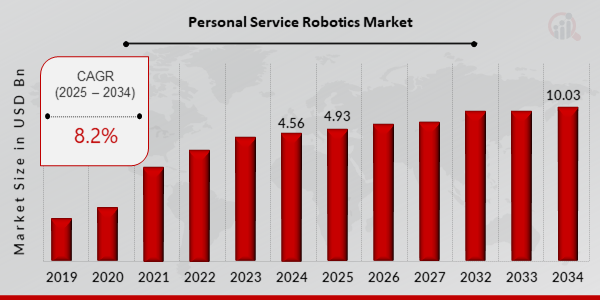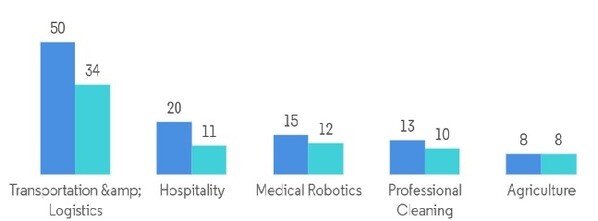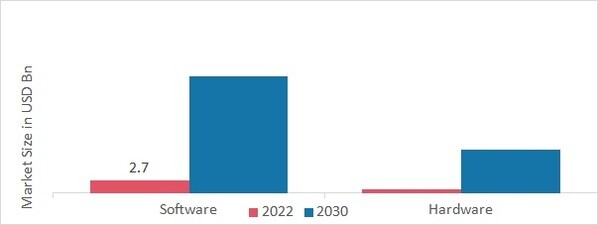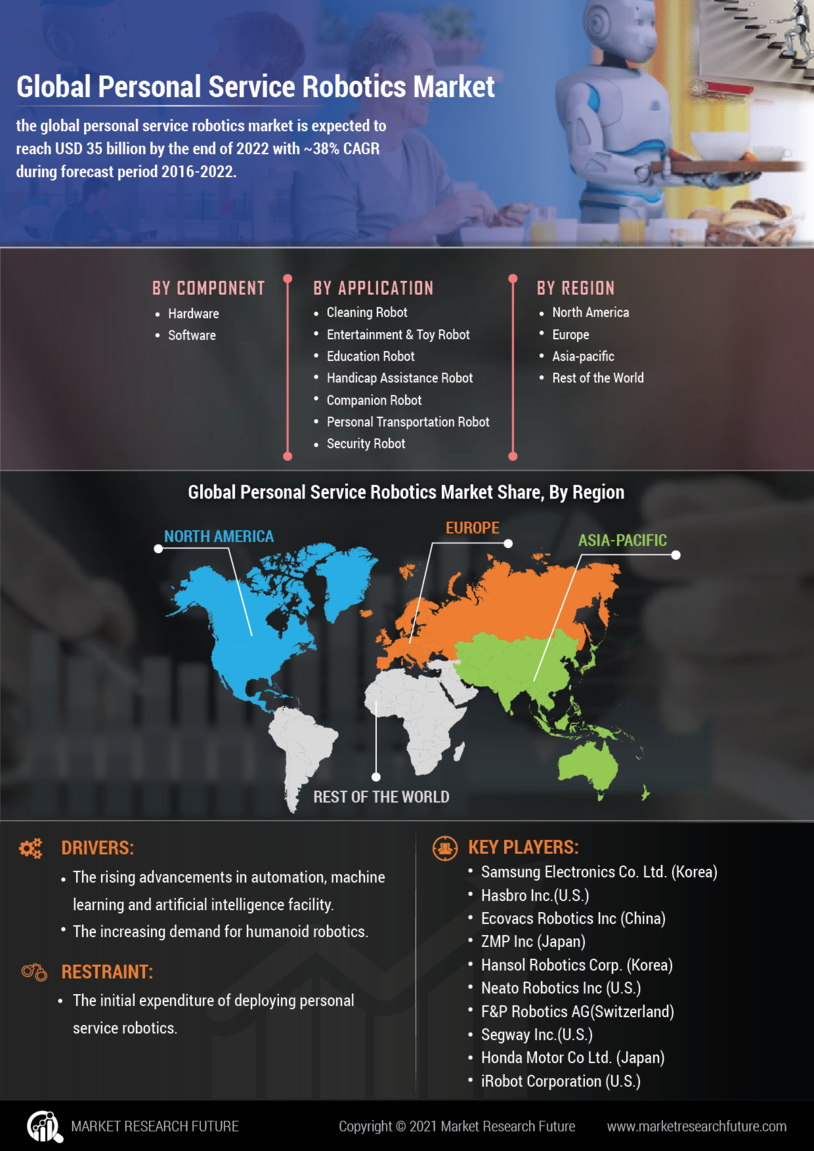Personal Services Robotics Market Summary
As per Market Research Future Analysis, the Global Personal Service Robotics Market was valued at USD 4.56 billion in 2024 and is projected to grow to USD 10.03 billion by 2034, with a CAGR of 8.2% from 2025 to 2034. Key drivers include the increasing adoption of IoT in robotics, a shift towards domestic robots, and advancements in intuitive technologies. The market is significantly influenced by the rising use of digital technology and automation across various sectors, including healthcare, construction, and agriculture. Major applications include consumer electronics, which dominated the market in 2022 and is expected to grow the fastest through 2030.
Key Market Trends & Highlights
The Personal Service Robotics market is witnessing significant growth driven by technological advancements and increasing demand across various sectors.
- Market Size in 2024: USD 4.56 billion
- Projected Market Size by 2034: USD 10.03 billion
- CAGR from 2025 to 2034: 8.2%
- Consumer Electronics segment projected to be the fastest-growing from 2022 to 2030
Market Size & Forecast
2024 Market Size: USD 4.56 billion
2034 Market Size: USD 10.03 billion
CAGR (2025-2034): 8.2%
Largest Regional Market in 2022: Asia Pacific
Major Players
Key players include Samsung Electronics Co. Ltd., Hasbro Inc., Ecovacs Robotics Inc, ZMP Inc, Hansol Robotics Corp., Neato Robotics Inc, F&P Robotics AG, Segway Inc., Honda Motor Co Ltd, and iRobot Corporation.
Increasing adoption of IoT in robotics, shifting towards domestic robots, and introducing intuitive technologies in robotics solutions are the key market drivers enhancing the Personal Service Robotics market growth.

Source: Secondary Research, Primary Research, MRFR Database and Analyst Review
Personal Service Robotics Market Trends
- Robotics in the Workplace and Growing IoT Usage in Robots for Economical Predictive Maintenance will boost Personal Service Robotics market growth
Field robots, security and defense robots, public assistance robots, electrical industry robots, and construction robots are all examples of professional robots. The need for Personal Service Robotics is driven by the rising use of digital technology and automation solutions across various industries. For example, service robots are used in the construction sector to combat high labor costs, labor shortages, and workplace hazards.
As there is less opportunity for human mistakes, it also aids in creating more trustworthy structures. Technologies like 3D printing and demolition robots further accelerate robot adoption in the construction industry. Public relations robots are made of exoskeletons. Most robots employed in public relations work as assistants. Due to the Personal Service Robotics industry's rapid technical development into automation, artificial intelligence, engineering, and machine learning, the market for service robots is constantly expanding.
Due to a trend in people using integrated robotic solutions for numerous crucial processes, medical service robots are anticipated to increase significantly throughout the projected period. Service robots will be widely employed in high-tech testing facilities in the medical industry. The results will also be more accurate thanks to the deployment of service robots in the testing facilities. Moreover, Personal Service Robotics are utilized by unmanned aerial aircraft. The agriculture and defense industries use these vehicles. These employees have the power to enhance the troops' performance and aid in keeping them safe.
These unmanned aerial vehicles can assess a product's ripeness in agriculture. Thus, this factor is driving the Personal Service Robotics market CAGR.
Figure 1: Use of Robots in Various Fields (2021 and 2022)

Source: Secondary Research, Primary Research, MRFR Database and Analyst Review
Increasing cost-effective predictive maintenance using IoT in robots. "Internet of Things" (IoT) refers to the digital networking of diverse devices and systems to develop cohesive operations. Predicting possible problems before they arise is known as predictive maintenance. Terabytes of data may be stored using an IoT-based system.
Machine learning (ML) algorithms can be performed concurrently on several computers to predict possible risks and identify when industrial equipment is most likely to break. This helps with predictive maintenance. Robotic sensor data from heat and voltage sensors is collected online and evaluated using machine learning (ML) methods. The Application of ML algorithms reveals hidden relationships in datasets and identifies irregular data patterns. Thus, this aspect will accelerate the Personal Service Robotics market revenue globally.
Personal Service Robotics Market Segment Insights:
Personal Service Robotics Component Insights
Based on Components, the Personal Service Robotics Market segmentation includes Hardware, Software. The Software Personal Service Robotics segment held the majority share in 2022, contributing around ~65-67% concerning the Personal Service Robotics Market revenue.
Figure 2: Personal Service Robotics Market, by Component, 2022 & 2030 (USD billion)

Source: Secondary Research, Primary Research, MRFR Database, and Analyst Review
Personal Service Robotics Application Insights
Based on Application, the Personal Service Robotics Market segmentation includes Automotive, Aerospace, Consumer Electronics, Servers and Data Centers, Aerospace and Defense, and Healthcare. Consumer Electronics dominated the Personal Service Robotics market in 2022 and is projected to be the fastest-growing segment from 2022 to 2030. The consumer electronics industry is anticipated to have the highest CAGR over the measurement period. Because of advancements in the gadget industry, the components may be applied to simpler and more sophisticated goods.
Personal Service Robotics Regional Insights
By region, the study provides market insights into North America, Europe, Asia-Pacific and the Rest of the World. Asia Pacific Personal Service Robotics market accounted for USD 5.35 billion in 2022. Due to the substantial presence of well-known international firms in the area, North America also holds a respectable market share. The top four automation solutions providers, ABB Ltd., FANUC, KUKA AG, and Yaskawa, have domestic markets outside North America.
Still, because of the Region's intense demand for their products and high rate of technological innovation, these manufacturers are being encouraged to expand their operations across the continent. Additionally, these companies' implicit efforts to advance technological advancements through significant investments in R&D operations, strategic partnerships, acquisitions, entering into collaborations, and joint ventures are recognized as key factors enhancing North America's development potential.
Further, the major countries studied in the market report are The U.S., Canada, Germany, France, the U.K., Italy, Spain, China, Japan, India, Australia, South Korea, and Brazil.
Figure 3: Personal Service Robotics Market SHARE BY REGION 2022 (%)

Source: Secondary Research, Primary Research, MRFR Database, and Analyst Review
Due to a sizable consumer base, the Asia Pacific Personal Service Robotics market is one of the areas with the highest growth rates globally. The demand for service robots is rising within this consumer base, particularly in nations like China, Japan, South Korea, and India, among others. IFR estimates that, for instance, professional robot sales will increase by roughly 30% in Asia in 2021.
Regional governments also significantly influence the growth of the local Personal Service Robotics market. As an illustration, India intends to invest in military robots and is getting ready to use sophisticated robotic warriors shortly. This is clear from the announcement made by the All India Robotics Association (AIRA) in January 2022 about the start of the domestic production of defense robots. Moreover, the China Personal Service Robotics market held the largest market share, and the India Personal Service Robotics market was the fastest-growing market in the Asia-Pacific region.
Europe Personal Service Robotics market holds the largest share due to the rising demand for personal and business robots in several of its member states. The location of several Personal Service Robotics market participants in this area. Throughout Europe, there are several industrial industries. The medical, defense, logistics, and retail sectors are increasingly in demand from these businesses.
Due to the increased acceptance of these robotic solutions in these nations, countries like Germany, the United Kingdom, France, and Italy are predicted to expand strongly throughout the projection period. Further, the Germany Personal Service Robotics market held the largest market share, and the U.K. Personal Service Robotics market was the fastest-growing market in the European Region.
Personal Service Robotics Key Market Players & Competitive Insights
Leading market players are investing a lot of money in R&D to expand their product portfolios, which will spur further market growth for Personal Service Robotics. With significant industry changes, including new product releases, contractual agreements, mergers and acquisitions, increased investments, and collaboration with other organizations, market developments are also undertaking various strategic activities to expand their global presence. To grow and remain in a market that is becoming increasingly competitive, Personal Service Robotics industry competitors must provide affordable products.
One of the primary business strategies Personal Service Robotics industry manufacturers utilize to service clients and expand the market sector is local manufacturing to reduce operating expenses. Some of the most significant benefits recently offered to medicine come from the Personal Service Robotics industry. The Personal Service Robotics market major player such as Samsung Electronics Co.
Ltd. (Korea), Hasbro Inc. (U.S.), Ecovacs Robotics Inc (China), ZMP Inc (Japan), Hansol Robotics Corp. (Korea), Neato Robotics Inc (U.S.), F&P Robotics AG(Switzerland), Segway Inc.(U.S.), Honda Motor Co Ltd. (Japan), iRobot Corporation (U.S.)and others are working on expanding the Personal Service Robotics market demand by investing in research and development activities.
Founded in 1967, Hyundai Motor Corporation, sometimes known as Hyundai Motors or just Hyundai, is a global South Korean automobile manufacturer headquartered in Seoul. Presently, the firm owns 33.88 percent of Kia Corporation and controls two other brands, including Genesis Motor, a division producing luxury automobiles, and Ioniq, which produces electric vehicles. The Hyundai Motor Group is made up of these three brands. HYUNDAI MOTOR GROUP purchased an 80% share in Boston Dynamics in June 2021 to bolster its position in the robotics industry.
An American technology business called iRobot Company creates and manufactures consumer robots. Three researchers from MIT's Artificial Intelligence Lab, who created robots for military defense and space exploration, started the company in 1990. To allow additional embedded smart home connections, iRobot teamed with If This Then That (IFTTT), a top online service integration and discovery platform. IFTTT will let iRobot connect products and services like smart thermostats, lighting, and home security into the iRobot HOME App.
Key Companies in the Personal Service Robotics market include
• Samsung Electronics Co. Ltd. (Korea)
• Hasbro Inc. (U.S.)
• Ecovacs Robotics Inc (China)
• ZMP Inc (Japan)
• Hansol Robotics Corp. (Korea)
• Neato Robotics Inc (U.S.)
• F&P Robotics AG(Switzerland)
• Segway Inc. (U.S.)
• Honda Motor Co Ltd. (Japan)
• iRobot Corporation (U.S.)
Personal Service Robotics Industry Developments
February 2020: Orpheus Medical supplies hospitals with information technology connections and competence in processing and preserving surgical footage; therefore, Intuitive Surgical purchased the company to expand its integrated informatics platform.
May 2022: In two locations in California, Uber Technologies Inc. began testing autonomous food delivery services. The business also disclosed a test program utilizing sidewalk robots and an autonomous vehicle-based food delivery service. Users in West Hollywood and Santa Monica, both in California, can use both services. The self-driving joint venture of Hyundai Motor Co. and Aptiv PLC, Motional, is working with the autonomous vehicle pilot project.
February 2022: To increase the capabilities of its digital process automation, Ricoh bought Axon Ivy AG as part of a strategic investment.
November 2021: Working together on the Smart Intelligence Robotic Project Cockpit was KUKA AG and MHP (SIRPCO).
Personal Service Robotics Market Segmentation:
Personal Service Robotics Component Outlook
Personal Service Robotics Application Outlook
Cleaning Robot
Entertainment & Toy Robot
Education Robot
Handicap Assistance Robot
Companion Robot
Personal Transportation Robot
Security Robot
Personal Service Robotics Regional Outlook
-
Europe
- Germany
- France
- UK
- Italy
- Spain
- Rest of Europe
-
Asia-Pacific
China
Japan
India
Australia
South Korea
Australia
Rest of Asia-Pacific
-
Rest of the World
Middle East
Africa
Latin America
| Attribute/Metric |
Details |
| Market Size 2024 |
USD 4.56 billion |
| Market Size 2025 |
USD 4.93 billion |
| Market Size 2034 |
USD 10.03 billion |
| Compound Annual Growth Rate (CAGR) |
8.2% (2025-2034) |
| Base Year |
2024 |
| Market Forecast Period |
2025-2034 |
| Historical Data |
2020 - 2023 |
| Market Forecast Units |
Value (USD Billion) |
| Report Coverage |
Revenue Forecast, Market Competitive Landscape, Growth Factors, and Trends |
| Segments Covered |
Product Type, Operating Platforms, and Region |
| Geographies Covered |
North America, Europe, Asia Pacific, and the Rest of the World |
| Countries Covered |
The U.S, Canada, Germany, France, the U.K., Italy, Spain, China, Japan, India, Australia, South Korea, and Brazil |
| Key Companies Profiled |
Samsung Electronics Co. Ltd. (Korea), Hasbro Inc. (U.S.), Ecovacs Robotics Inc (China), ZMP Inc (Japan), Hansol Robotics Corp. (Korea), Neato Robotics Inc (U.S.), F&P Robotics AG(Switzerland), Segway Inc.(U.S.), Honda Motor Co Ltd. (Japan), iRobot Corporation (U.S.) |
| Key Market Opportunities |
The deployment of robotics is essential in every field. |
| Key Market Dynamics |
The demand for robotics has reached a peak during the past two decades. |
Personal Services Robotics Market Highlights:
Frequently Asked Questions (FAQ):
The Personal Service Robotics Market size was valued at USD 4.56 Billion in 2024.
The Personal Service Robotics Market is projected to grow at a CAGR of 8.2% during the forecast period, 2025-2034.
North America had the largest share in the Personal Service Robotics Market.
The key players in the Personal Service Robotics market are Samsung Electronics Co. Ltd. (Korea), Hasbro Inc.(U.S.), Ecovacs Robotics Inc (China), ZMP Inc (Japan), Hansol Robotics Corp. (Korea), Neato Robotics Inc (U.S.), F&P Robotics AG(Switzerland), Segway Inc.(U.S.), Honda Motor Co Ltd. (Japan), iRobot Corporation (U.S.)
The Non-adhesive category dominated the Personal Service Robotics market in 2022.
Consumer electronics had the largest share in the Personal Service Robotics Market.



















